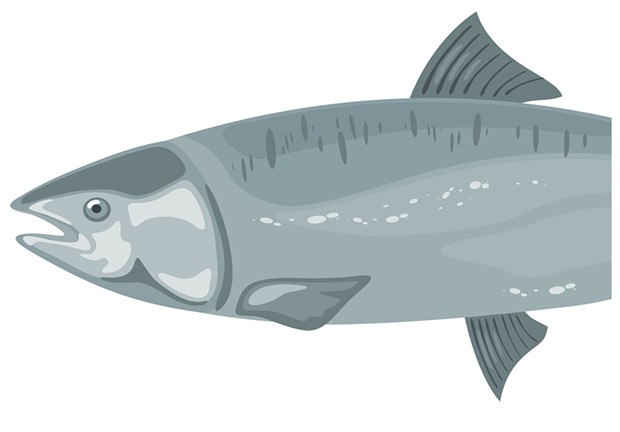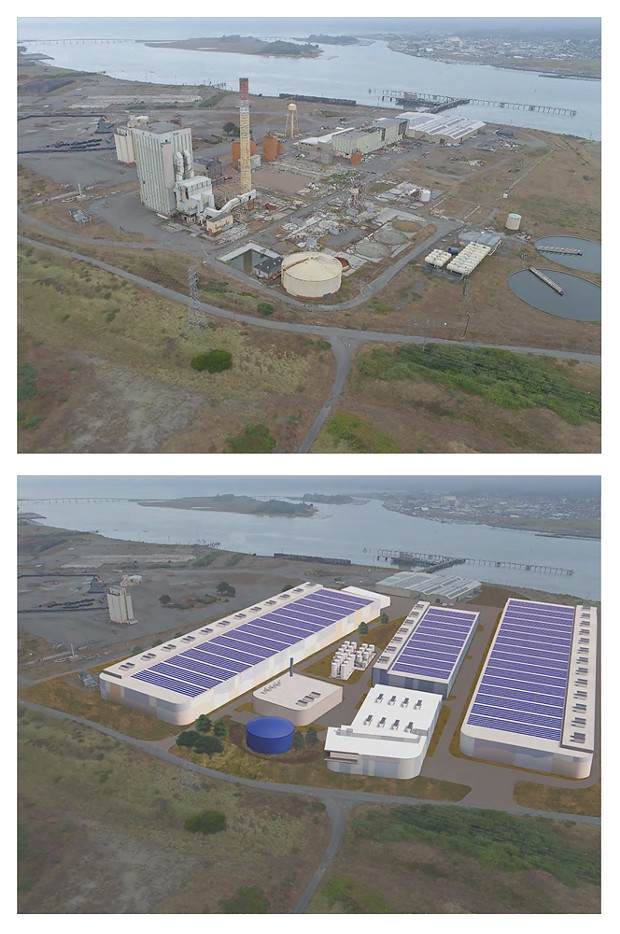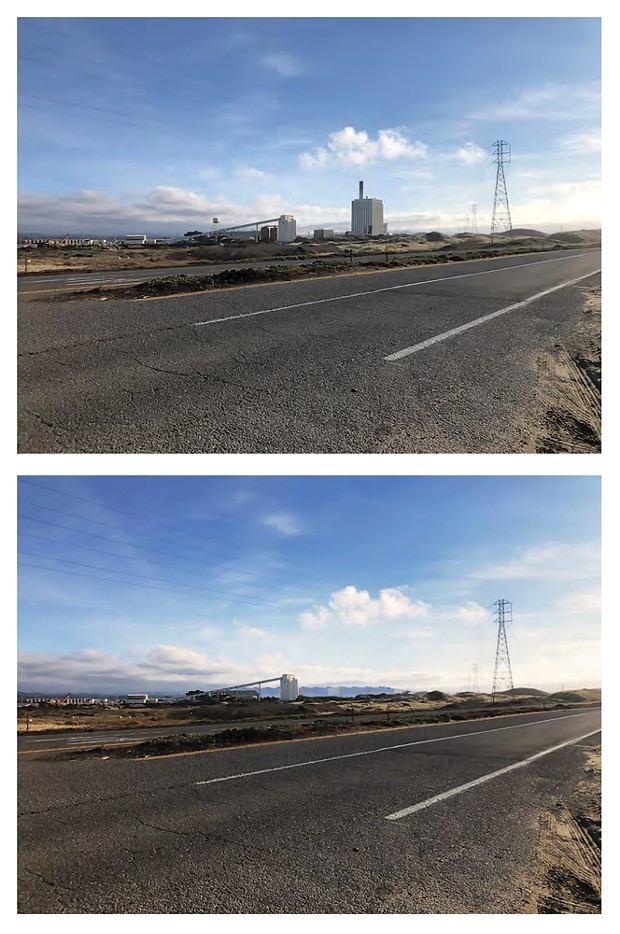Quantifying Impact
Environmental review for massive Samoa fish farm heads to planning commission
By Elaine Weinreb[
{
"name": "Top Stories Video Pair",
"insertPoint": "7",
"component": "17087298",
"parentWrapperClass": "fdn-ads-inline-content-block",
"requiredCountToDisplay": "1"
}
]
I n 2019, Nordic Aquafarms approached the county with a unique proposal: Using some derelict land owned by the Harbor District, the Norway-based company wanted to build a giant land-based fish farm, with Atlantic salmon raised in tanks, separated from the waters of the ocean and Humboldt Bay, and marketed all over the nation. As part of the deal, Nordic would first clean up the highly polluted site, which was last occupied by the now defunct Samoa pulp mill, saving the district and the county millions of dollars. Nordic also promises the project will bring hundreds of good-paying jobs throughout the course of site cleanup, construction and ongoing operations.
State and federal law require environmental assessment of most projects. At first, the county proposed a minimal level of environmental review, called a Mitigated Negative Declaration, for Nordic's proposed fish farm. However, in response to public criticism, the company decided to commission a full-scale Draft Environmental Impact Report (DEIR), which was about 1,500 pages long, including a 10-page list of acronyms, and dozens of highly technical appendices. This was released in February.
The purpose of the DEIR is to explain all possible environmental ramifications of the project, to collect public comments on these issues and, where necessary, identify mitigation measures. The letters of comment, the company's responses to them and some legal details were then published July 1 in a separate document called the Final Environmental Report (FEIR), containing hundreds of comments from members of the public and various organizations.
The Humboldt County Planning Commission is now slated to take up the FEIR, which now sits at close to 3,000 pages, on July 28 to determine if it adequately assesses the project's potential impacts of what would be the world's largest land-based recirculating aquaculture system. Certification of the document would be needed for the company to continue in the permitting process.
As described by the California Department of Fish and Wildlife: "The project site is situated on the Samoa Peninsula, bounded on the west by dunes and the Pacific Ocean and on the east by Humboldt Bay, and located at the site of the former Samoa Pulp Mill in the unincorporated community of Samoa in Humboldt County.
"The proposed aquaculture facility will include operations to grow-out fish
from egg to harvestable size. The fish will be contained indoors in separate buildings connected by underground pipes for fish transfer.
"At full capacity, the facility will have an annual production of approximately 25,000 metric tons of head-on-gutted fish," CDFW continued. "The project will require approximately 2.5 million gallons per day of freshwater sourced from the Mad River and 10 million gallons per day of seawater sourced from Humboldt Bay. Treated wastewater (12.5 million gallons per day) will be discharged into the Pacific Ocean utilizing the existing Redwood Marine Terminal ocean outfall pipe located 1.55 miles offshore of the Samoa Peninsula."
The project will see five buildings constructed — for intake water treatment, grow-out modules, a hatchery, fish processing and wastewater treatment — with a combined 766,530-square-foot footprint.
The project will also include "ancillary support features," including a paved parking lot, fire access roads, security fencing, stormwater management and a fire suppression water line, according to the report, which notes that all of this construction would take place after existing environmental contamination is remediated.
As might be expected, public comments for the project fall into two basic groups: Those who support the project because of its perceived economic benefits to the community, and those that oppose it because of its perceived environmental hazards.
For example, the Humboldt Bay Municipal Water District, which supplies both the peninsula with untreated water for industry and most of Humboldt's larger towns with treated drinking water, strongly supports the project. The water district was originally formed to supply the peninsula's pulp mills with Mad River water. When the mills closed, it was left with a massive surplus, which it could forfeit under the state's "use it or lose it" policies. As such, the district wants new industrial customers.
College of the Redwoods, which hopes to open its own aquaculture program, sees Nordic as an ally in this effort.
Some at Cal Poly Humboldt agree: "As an aquaculture professor ... I see great opportunities to collaborate with Nordic," wrote Cal Poly Humboldt associate professor Rafael Cuevas-Uribe. "Our students could do internships at Nordic and [be] employed by them. We can do research of any need that they could have."
Others say the project could have a ripple effect, providing a boon for the area.
"The Nordic project will potentially be a draw for other aquaculture or sustainable businesses on the peninsula, thereby increasing economic prosperity and employment opportunities for our region," said Fortuna Chamber of Commerce CEO Renee Lindsay.
Another commenter, Greg Page, said the project will put people to work locally while also providing "training opportunities for apprentices so we can grow the next generation of skilled working people."
Many individuals — 132 of them, in fact — shared these opinions.
However, organizations and individuals concerned primarily with the environment offered many criticisms of — and concerns with — the project.
The Manila Community Services District focused on traffic impacts the project would bring.
"The tiny community of Manila is thoroughly bisected by [State Route] 255 which contains no traffic control, no stop signs, minimal lighting and no crosswalks between the one side of the town, with an elementary school and beach access, and the community park and market on the other," said a letter from the MCSD Board of Directors. "Additional traffic loads from employees commuting to and from work, along with the estimated additional 95 truck runs per week, will have a tremendously disruptive impact on our community."
Other commenters challenged Nordic's traffic statistics, saying they grossly undercounted the number of cars and trucks the project would bring.
"Project-related truck traffic does not present a significant intensification of use
beyond what the road network currently experiences and accommodates," the FEIR responded.
The California Department of Fish and Wildlife expressed concern about effects on native salmon populations.
"The California Legislature made it unlawful to spawn, incubate or cultivate any transgenic or exotic species of finfish belonging to the family Salmonidae in the waters of the Pacific Ocean regulated by the state," CDFW wrote. "While land-based facilities are generally regarded as posing substantially fewer risks to the local environment than marine net pens, the proximity of the project site to Humboldt Bay and the Pacific Ocean, coupled with the proposed seawater intakes and discharge of effluent into the Pacific Ocean, is concerning."
The project would also be built in a region that is "home to some of the state's most commercially and culturally significant salmon runs of wild Pacific Salmon, some of which are also at risk of extinction," CDFW wrote.
"CDFW understands that the potential for cultured Atlantic salmon to escape from the facility into local marine, estuarine and freshwater environments is low, but does not consider the risk to be eliminated, and is concerned with the potential consequences of an escape event to vulnerable, native species," CDFW continued. "The project's proposed location is subject to seismic and tsunami hazards and may hold millions of Atlantic salmon as close as 300 feet from Humboldt Bay at any one time. Even well-designed land-based facilities outside of tsunami hazard areas have had unintended releases due to structural or operational failures... the risk of intentional or unintentional release of fish cannot be completely eliminated."
The agency was also concerned about the risk to tiny marine organisms posed by the facility's water intake systems. These organisms, some of which are themselves baby fish, provide food for other animals higher up on the food chain.
Another item of concern is the wastewater, which is expected to be about 20 degrees Fahrenheit warmer than the surrounding ocean water, although it will cool rapidly as it diffuses.
Most but not all of the contaminants commonly found in wastewater will be removed by the project's wastewater treatment system, adding a small but consistent degree of contamination to the ocean waters.
CDFW is also concerned about the project's effects on eelgrass, which is protected by state and federal policies because of its importance to fisheries, and also the impact to ospreys which nest in the area.
"The Draft EIR does not include implementation of a mitigation plan in the event that impacts to water quality or biological communities are observed," CDFW wrote.
Nordic's document responds: "The prevention of fish escape is one of the highest priorities for NAFC, and the facility is designed around escape prevention ... . The proposed facility will feature multiple physical barriers both within and outside the tanks that will block the passage of fish and eggs ... . The proposed facility in Humboldt also includes structures designed to withstand a major seismic and tsunami event."
The document then describes the multiple barriers that would prevent fish from escaping and mentions "there is no opportunity for an operator to release fish accidentally or intentionally from a tank directly into the sea."
Although there are a few records of fish escaping from Norwegian land-based fish farms, Nordic states that those facilities were unlike the planned Humboldt facility in many ways.
Even if any escape should somehow occur, Nordic says that "use of an all-female stock would prevent reproduction in nature." In addition, the company notes, "domesticated fish are unlikely to survive outside of the controlled environment where they receive regular feeding because domesticated fish have limited prey foraging skills."
The FEIR also describes a rigorous fish health management plan.
The National Marine Fisheries Service had similar comments to CDFW's, expressing even greater levels of concern than the state did. The agency also criticized Nordic's dismissal of the possibility of harmful algal blooms occurring as a result of the warm water discharged into the ocean from the facility.
"Do to a lack of monitoring in the discharge area, we do not know the algal species composition in the project area, although the California Department of Public Health has frequently prohibited shellfish harvesting due to the presence of domoic acid" (a naturally-occurring neurotoxin caused by certain algae), the agency said.
Nordic responded with several scientific reasons why this was unlikely to occur.
The Wiyot Tribe also expressed concerns about harmful algal blooms.
"There is concern over further elevating the water temperature in our region as our oceans are already warming," the tribe wrote in a letter, also expressing concern that certain culturally important species, such as the endangered longfin smelt, could be harmed by the project.
The Wiyot Tribe also expressed concern about the energy demands of the project and recommended that Nordic increase the size of the onsite solar electricity system and commit to purchasing "local, carbon free, renewable electricity, whenever it is available and feasible to purchase."
Representatives of local fishing organizations expressed concern about the effects the project might have on their livelihoods, with cheaper farmed salmon supplanting the market share of its more expensive, wild-caught counterpart.
The Blue Lake Rancheria expressed support of the project but wanted to see a plan to protect water quality in the event of a system failure. Nordic maintained such a plan is already in place.
The project will be powered by electricity, a very large amount, which is problematic in the eyes of some commenters.
Electrical energy at present is generated from power plants that burn natural gas, releasing carbon dioxide, a greenhouse gas the state is trying to reduce due to its exacerbating impacts on the climate crisis. As such, the state is working to replace natural gas electric production with renewable sources, like solar and wind, a goal that is embraced in the county's Climate Action Plan.
Nordic plans to build some 15 acres of rooftop solar arrays in the construction of its facilities, which would provide roughly 20 percent of the facility's electricity, but environmental groups have charged that's not enough.
In the words of the Sierra Club, "The Nordic facility would add electric power demands equal to half of our residential use today, a scale of impact which
demands serious consideration."
The electrical demands of the proposed project would equate to about 21 percent of Humboldt County's current usage, an amount currently consumed by the cities of Eureka and Fortuna combined.
"California's strategy for countering climate change and reaching net-zero emissions in 2045 is to convert electric power generation to renewables and then to 'electrify everything,'" the Sierra Club continued. "In particular, vastly more electricity will be used as we convert to electric vehicles and as we convert our gas and wood stove powered housing and buildings to electric heat pumps. An official California strategic plan released in May 2021 estimates that in order to meet S.B. 100 goals in 2045, California will need three times the electricity that we use today."
If an offshore wind project currently being studied off Humboldt's coast is built, the letter continues, "there will probably be sufficient sources of renewable energy for the county, including the 22.3 megawatts Nordic would add."
"But what will be the situation if we do not get wind power?" the Sierra Club asks.
Currently, the Humboldt Bay Generating Station can produce about 160 megawatts of energy, according to the Sierra Club, with the Humboldt sawmill biomass plant (classified as "renewable" but which is "high-carbon") can produce another 15 megawatts and the county able to import another 70 megawatts of renewable electricity from outside its borders.
"In summary," the Sierra Club continued, "if we don't get wind power, our local energy capacity is likely to be barely sufficient for our demand, and we will get less than half of our power from renewable sources. This is the situation if Nordic is not built. If it is built, it adds another 22.3 [megawatts] to the total capacity needed and to the demand for the insufficient supply of renewable energy."
This scenario, the Sierra Club warns, would imperil Humboldt County's ability to meet state requirements to convert toward 100-percent renewable energy by 2045, arguing that this alone should require "a finding of significant impact under CEQA."
The FEIR's response is the project will follow the lead of the Redwood Coast Energy Authority (RCEA). RCEA describes itself as the "community choice aggregator for Humboldt County, serving 63,000 electric account customers and supporting energy efficiency alongside local, clean and renewable energy solutions."
Nordic anticipates the project opening in 2025, according to the document, which coincides with RCEA's goal of providing 100 percent renewable energy through a mix of "state-designated, net-zero carbon emission" sources.
"This commitment is ... fully enforceable by the county through the county's Coastal Development Permit (CDP) conditions of approval," the document states.
Nordic has also previously charged that electricity demands aside, the project would lead to a net reduction in global greenhouse gas emissions because it would provide a domestic supply for the large amounts of salmon the U.S. currently imports from Europe with a huge carbon footprint.
These were just a few of the hundreds of comments received from the public. Some were heartfelt one-line statements from individuals; others were lengthy, well-documented tomes from various environmental organizations.
Outside of the scope of the FEIR, the two top executives of Nordic Aquafarms, co-founder Erik Heim and Executive Vice President Marianne Naess, who'd combined to be the public face of Nordic in Humboldt County, abruptly announced their departure from the company July 5, giving no reason other than the desire to pursue new opportunities. A press release announced Brenda Chandler, a Maine native, will be the interim CEO.
The project's next step is up to the Humboldt County Planning Commission, which will begin the process of deciding whether to certify Nordic's FEIR at its July 28 meeting.
Elaine Weinreb (she/her) is a freelance journalist. She tries to re-pay the state of California for giving her a degree in environmental studies and planning (Sonoma State University) at a time when tuition was still affordable.
Editor's note: This story was updated from a previous version to correct an error and reflect that Nordic did respond to inquiries about the departures of executives Erik Heim and Marianne Naess from the company. The Journal regrets the error.
Comments
Showing 1-1 of 1
more from the author
-
Trouble on the Mountain
A popular outdoor recreation area is also a makeshift shooting range, causing growing safety concerns
- Jan 11, 2024
-
Port of Entry
Harbor District begins environmental review for project to turn Humboldt Bay into a wind farm manufacturing hub
- Jul 27, 2023
- More »
Latest in News
Readers also liked…
-
Through Mark Larson's Lens
A local photographer's favorite images of 2022 in Humboldt
- Jan 5, 2023
-
'To Celebrate Our Sovereignty'
Yurok Tribe to host gathering honoring 'ultimate river warrior' on the anniversary of the U.S. Supreme Court ruling that changed everything
- Jun 8, 2023


































